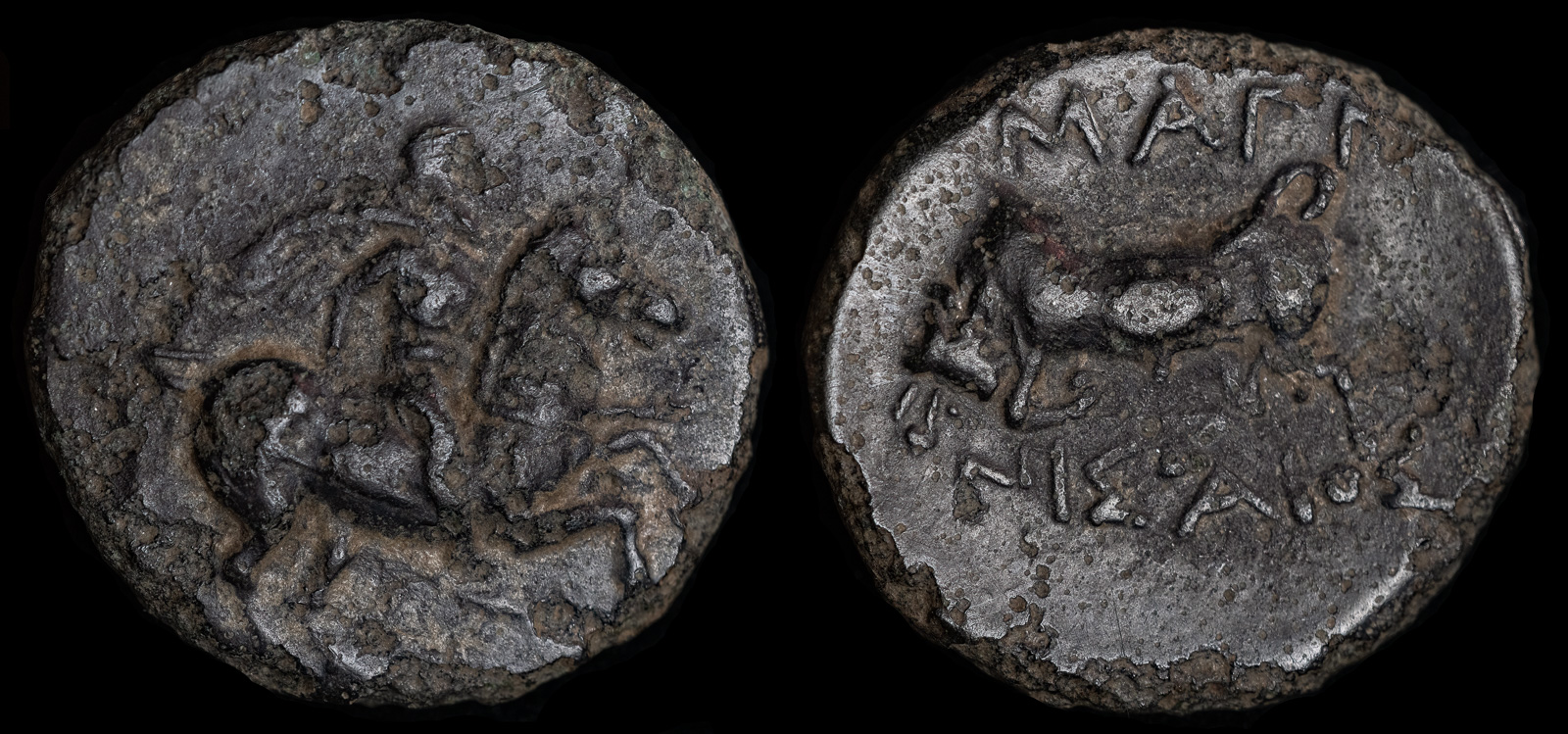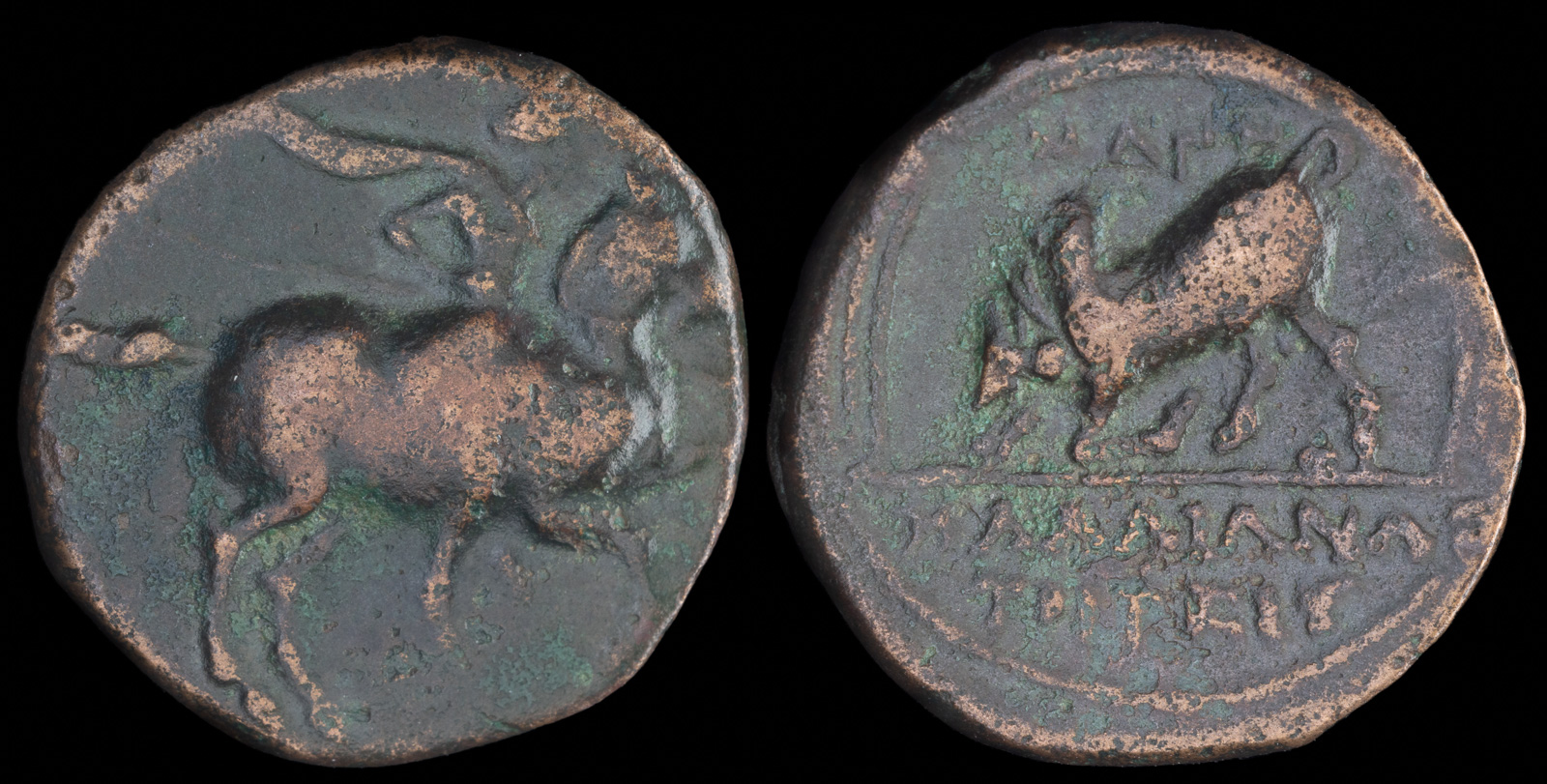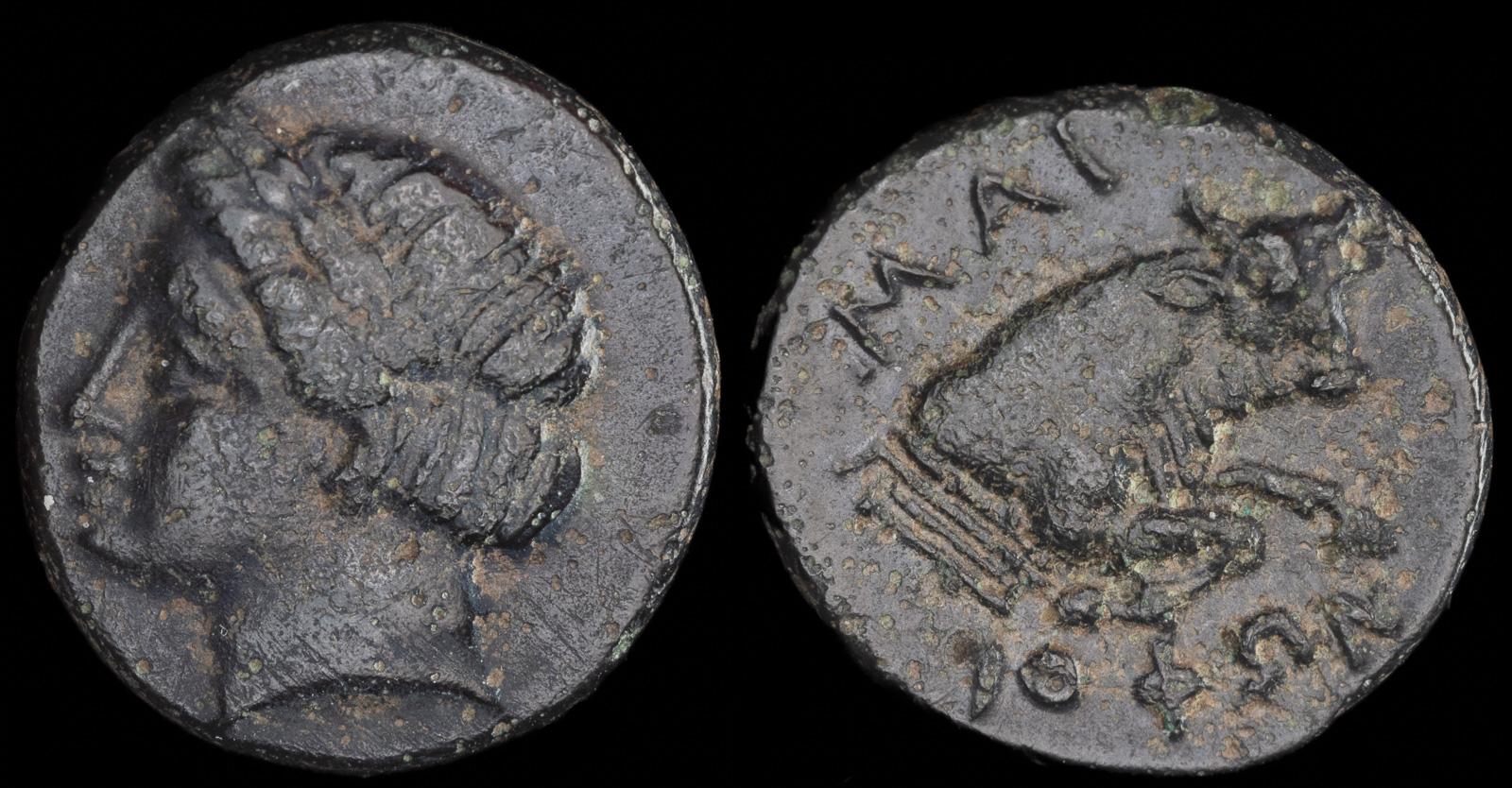
Ionia. Magnesia ad Maeander circa 350-200 BC.
Æ 15 mm, 3,42 g
Warrior, holding couched lance, on horse rearing right /
Bull butting left; Aristeos son of — in two lines in exergue; all within circular maeander pattern.
Newell, Five, p. 44, 12; SNG Copenhagen 826-40 var. (magistrate)
As was typical at the time, there were several cities around the same area that were called ‘Magnesia’. Magnesia ad Meander was likely the most powerful of them and received its name (as did the others) because it was originally settled by people from Magnetes, Thessaly.
Due to its excellent climate and weather, the region soon became famous for its figs, wine, and cucumbers.
The city is perhaps best known in history for the Athenian Themistokles, who was given the city to rule by Ataxerxes.

Ionia. Magnesia ad Maeander
Nisaios magistrate
circa 350-200 BCE
Æ 15 mm, 2,20 g
Obv: Galloping warrior on horseback right, attacking with spear.
Rev: MAΓN NIΣAIOΣ. Humped bull butting left.
BMC -; SNG Copenhagen -; SNG von Aulock -; SNG Tübingen -; Leschhorn p. 716
Strabo visited the city and marveled at its temple to Artemis Leukophryene, which he noted was superior in harmony and beauty to all other temples in Asia Minor. Parts of this temple were dug up and preserved at the Pergamon Museum in Berlin. The city’s stadium remains well-preserved, while the rest of the site consists of scattered remains, since most buildings have been destroyed by the locals over time.

Ionia, Magnesia ad Maeander
ΚΥΔΡΟΚΛΗΣ (Kydrokles), magistrate
circa 350-200 BCE
Æ 17mm, 3,12g
Horseman riding right, holding lance /
Bull butting left, MAΓN above, KYΔPOKΛHΣ and grain ear in exergue, all within circular maeander pattern border.
BMC 26; SNG Copenhagen 814
In ancient times, people facing persecution could escape to the temple of Artemis and find safety there.

Ionia, Magnesia ad Maeander
ΚΑΛΛΙΑΝΑΞ ΤΡΙΤΕΟΥ magistrate
circa 350-200 BCE
Æ 17mm, 3,80g
Obv: Galloping warrior on horseback right, attacking with spear
Rev: ΜΑΓ / ΚΑΛΛΙΑΝΑΞ ΤΡΙΤΕΟΥ.
Humped bull butting left; all within maeander circle
Waddington 1731

Ionia, Magnesia ad Maeander
Poseidi-, magistrate
circa 350-200 BCE
Æ 16mm, 4,05g
Horseman riding right, holding lance
Rev. MAΓN / ΠΟΣΕΙΔΙΠ Bull butting left; all within maeander pattern.
BMC -. Imhoof-Blumer KM 14. SNG Copenhagen -. SNG von Aulock –

Ionia, Magnesia ad Maeandrum
Poseidip(pos) magistrate
Circa 350-200 BCE
Ae 1.22g 12.07mm
Obv: Galloping warrior on horseback right, attacking with spear.
Rev: MAΓ *ΣΕΙΔΙ*. Humped bull butting left.
BMC -; SNG Copenhagen -; SNG von Aulock -; SNG Tübingen

Ionia, Magnesia ad Maeandrum
-ΝΓΜΣΙΑ-, magistrate
Circa 350-200 BCE
Ae 2.45g 15.10mm
Obv: Galloping warrior on horseback right, attacking with spear.
Rev: MAΓN ΝΓΜΣΙΑ. Humped bull butting left.
BMC -; SNG Copenhagen -; SNG von Aulock -; SNG Tübingen

Ionia, Magnesia ad Maeander
circa 350-200 BCE
Kallianax Triteou magistrate
Æ 17mm, 3,86g
Obv: Galloping warrior on horseback right, attacking with spear.
Rev: ΜΑΓ / ΚΑΛΛΙΆΝΑΞ TRITEOU, Humped bull butting left; all within maeander circle.
Imhoof-Blumer Greek Coins 119,306

Ionia, Magnesia ad Maeandrum
Iophon, magistrate
350-200 BCE
Ae 13.05mm 1.93g
Date: 350-200 BC
Obverse: Laureate head of Apollo left
Reverse: MAΓ / IOΦΩN, forepart of bull right
SNG Copenhagen 802 var. (magistrate)
Ex CNG 2009
Ex D. Alighieri Collection
Magnesia ad Maeander is destroyed by Cimmerians.
The Athenian Themistokles is given control over Magnesia ad Maeander.
Death of Themistokles in Magnesia ad Maeander. His son Archeptolis succeeds him as governor.
Archeptolis, who controls Magnesia ad Maeander, is removed, possibly by Tissaphernes.
Adramytteion, Ephesos, Pergamon, Magnesia, Tralles, Apamea, Samos, Kolophon, Smyrna, and Sardis occupied by Mithridates VI as part of the Mithridatic Wars against Rome.
Sulla defeats Mithridates VI and ends the Mithridatic Wars with the Treaty of Dardanos. Adramytteion, Ephesos, Pergamon, Smyrna, Sardis, Tralles, Kolophon, Apamea, and Magnesia return to Roman control.
Adramytteion, Aigai, Philadelphia, Apollonis, Smyrna, Sardis and Magnesia are severely damaged by an earthquake. Tiberius provides financial support.